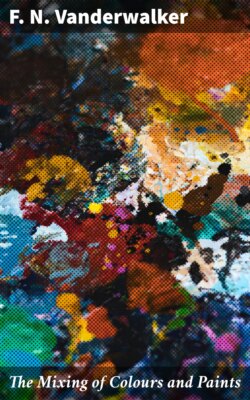Читать книгу The Mixing of Colours and Paints - F. N. Vanderwalker - Страница 18
GREENS
ОглавлениеThere is an abundance of valuable green pigments useful for interior decorating, furniture finishing and general decorative purposes which are not commonly used for tinting exterior paints. Emeraude green (called veridine green), cobalt green and oxide of chromium are all dependable greens where brilliance and clear tones are needed.
Beautiful olive green tints and shades may be mixed from emeraude green and raw sienna toned with zinc yellow.
Cobalt Green is a semi-transparent color and is permanent and stable for intermixture with other colors. Mixed with zinc it makes beautiful green tints.
Permanent Green.—The colors called permanent greens are less expensive than emeraude and veridine greens and serve many purposes quite as well. They are chemically the same, but are extended with alumina hydrate.
Emerald (Paris) Green.—An aceto-arsenite of copper color and the most brilliant of all greens. It has little strength as a tinting color. Used alone it is opaque. It is not a good color to mix with other colors, being not chemically agreeable. Green tints and shades quite as useful can be mixed from emeraude green and lemon cadmium yellow. Being a compound of copper and arsenic, emerald green is very poisonous and is used much more as an insecticide than as paint.
Emeraude (viridian) Green.—A brilliant color and the most permanent to light. Completely stable chemically and may be mixed with all other colors. Chemically it is hydrate sesquioxide of chromium.
Malachite Green.—Made from a copper base and has little tinting strength. It is especially fugitive in the presence of sulphuretted hydrogen gas from stagnant water. Chemically it is hydrated carbonate of copper. Its color can be matched with emeraude green, zinc oxide and raw sienna.
Verdigris Green.—Used alone for glazing to a limited extent, but rather fugitive to light and especially affected by sulphur gasses. Must not be used with lake colors, which it destroys. Chemically it is acetate of copper.
Brunswick Green.—Also called Bremen green. A variation of chrome green.
Chrome Oxide Green.—An oxide of the metal chromium. A very useful green permanent in light. Stable chemically and may be mixed with all other colors. It is opaque and drys well. It is not the same as ordinary chrome green made by precipitating Prussian blue and chrome yellow together. Chrome oxide green ranges in color from dull olive to bluish green. It hasn't much tinting strength for mixture with white, but it is very fast in color. It doesn't fade in strong light and is little affected by acid or alkali.
Lime Proof Green.—Used for calcimine and cement tinting purposes. Made from a natural earth called terre verte or green earth which absorbs Emerald (Paris) green crystals and auramine yellow, an aniline basic color. These greens are not changed by alkali and are much improved in their permanence of color in strong light.
Sap Green.—A rather permanent color made from coal tar dye.
Zinc Chromate.—Bright yellowish green of a deep lemon yellow color.
